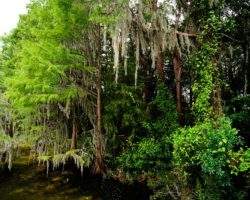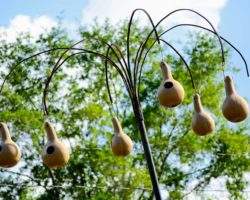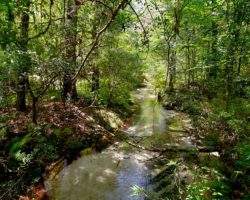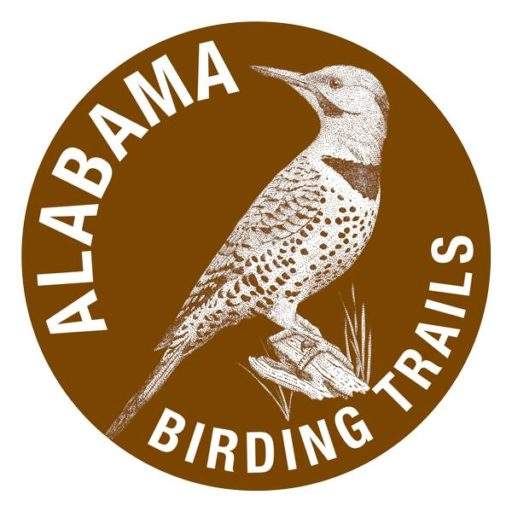Wiregrass | Covington | Best Seasons: Fall | Spring | Winter
The Conecuh National Forest preserves more than 83,000 acres of diverse habitats ranging from broad tracts of mature, open Longleaf Pine forest and dense pine-oak-hickory woodlands to extensive lily-pad swamps, early second-growth scrub, dense wet tangles and open lakes with manicured banks. Much of the forest may be accessed via paved highway. There are also numerous well-maintained Forest Service roads that lead to some of the wilder, less-visited portions of the forest. The Conecuh Trail traverses the forest, too. Trail maps and other information for this Alabama Birding Trails site may be picked up at the ranger station.
Blue Lake and Open Pond recreation areas offer swimming, fishing and visitor amenities such as picnic tables and restrooms. They are located within a few minutes of one another, both accessed by well-marked roads off AL 137, and are perhaps best for woodland songbirds found in the trees and scrub back a bit from the water. The degree to which the cover near the lakes has been mowed limits the level of avian activity there, though there will still be long-legged waders, some shorebirds (in season), and perhaps a limited number of waterfowl. Blue Lake Recreation Area is closed from November to March. In spring and summer, the woods around these lakes ring with songs from Northern Parulas, Yellow-throated Warblers, Prothonotary Warblers, American Redstarts, Eastern Towhees, White-eyed Vireos, and Common Yellowthroats.
Note that at the Open Pond area there are actually three bodies of water. Open Pond is the large, tourist-friendly lake reached by a modern paved road. Ditch and Buck Ponds are on the opposite ends of a short dirt road reached by continuing on the main entrance road past the turn to Open Pond until you reach a “T,” where signs point to the short drive to these two small lakes. These smaller bodies of water consistently host waders and shorebirds; Wild Turkeys and Northern Bobwhites often appear to drink or bathe, as does other wildlife like foxes and bobcats.
From these more-developed sites, return to AL 137 and head south. Beda Road is a westbound road off AL 17 that allows access to numerous other bodies of water, both large and small. These range from the relatively tiny Otter Pond to the larger Falco, Wolf Thicket, and Bear and Blackwater Bays. You should find Purple Gallinules, Common Moorhens, Anhingas, Ospreys, Swallow-tailed Kites, and Painted Buntings in and around these bodies of water. Search hard for Least Bitterns and King Rails in the margins of the ponds and bays.
For a rare opportunity to view colonies of the endangered Red-cockaded Woodpecker, return to AL 137 and continue south. The last right (west) turn before the Florida line should be CR 4. Turn right on CR 4 and continue just over 1.25 miles to a right turn on FS 321. Turn right and park. This tract of mature Longleaf Pine is the beginning of some of the best-managed and most productive Red-cockaded Woodpecker habitat anywhere. At last count, the Conecuh was home to at least 88 clusters of these endangered birds, and this spot at the intersection of CR 4 and FS 321 is the beginning of one of the more densely populated stretches. The numerous white-banded pines are cavity trees. The birds are present in this vicinity in the early morning and late afternoon, as well as much of the day in April and May when young birds are being tended at the nests. The extensive Longleaf Pine forest here and throughout the southern portion of the Conecuh National Forest includes additional nesting compartments, foraging stands, and recruitment stands for numerous groups of Red-cockaded Woodpeckers. The woods are beautifully managed and offer a perfect home for this rare bird.
The same Longleaf reservation provides a home for large numbers of Bachman’s Sparrows, Brown-headed Nuthatches, Indigo Buntings, Field Sparrows, Blue Grosbeaks, Red-headed Woodpeckers, Common Ground Doves, and many other species. The forest is biologically rich and diverse, and the species list is quite extensive. Winter brings many additional species to the Conecuh; look for Blue-headed Vireos, Orange-crowned Warblers, and around the grassy wetlands, rare wintering sparrows, such as Henslow’s and LeConte’s.
The proximity of the forest to Florida, along with the tremendous variety of habitats available here make the Conecuh a good place to search for stray or extralimital species from farther south. Watch for Limpkins, Short-tailed Hawks, and in winter, Groove-billed Anis.
The Conecuh National Forest stands as one of Alabama’s finest birding sites, and is a prized part of the Alabama Birding Trail system. It is productive and reliable for some of our rarest and most sought-after birds, and should be considered one of the state’s premier birding destinations – in the same league as Wheeler National Wildlife Refuge, Lake Guntersville, and Dauphin Island.
GPS: 31.092411 -86.54123
Conecuh National Forest
24481 Alabama Hwy 55
Andalusia, AL 36420
334-222-2555
From Andalusia in Covington County (fuel, food, and lodging available), proceed south on US 29 for 11.2 miles. Take the left fork onto AL 137 and continue for approximately 4 miles to enter the Conecuh National Forest. The vast acreage is accessed by a network of roads, some paved, (AL 137 runs north-south, US 29 runs east-west) or county roads (CR 4 and CR 24 run east-west).
Amenities Available:
Nearby Sites

Florala City Wetland Park
The twin sites along the shores of 500-acre Lake Jackson provide boardwalk access through and above cypress hammocks, palmetto and scrub woods, and dense tangles of wetland and swamp plants. This is a superb site for wetland-loving songbirds, and a r …

Frank Jackson State Park
Frank Jackson State Park is a 2,050-acre park centered on 1,000-acre Lake Frank Jackson, and offers boating, fishing, swimming, hiking, camping, and picnicking. There are also a number of nature trails and boardwalks providing access to islands and m …

Solon Dixon Forestry Education Center
The Solon Dixon Forestry Education Center in the Conecuh National Forest is operated by Auburn University and hosts classes and conducts research projects throughout the year. The 5,300-acre tract offers a tremendous diversity of plants, many of whic …
